Introduction
Przewalski's gazelle Procapra przewalskii, endemic to the Qinghai–Tibetan Plateau, China, was recategorized on the IUCN Red List from Critically Endangered to Endangered in 2008 (Jiang et al., Reference Jiang, Feng, Wang, Chen, Cai and Li1995, Reference Jiang, Lei, Han and Li2003; Jiang, Reference Jiang2004; IUCN SSC Antelope Specialist Group, 2008). It is also listed as a Category I Key National Protected Wild Animal Species and regarded as a conservation priority, together with 12 other animal taxa and two plant taxa, in China (Jiang et al., Reference Jiang, Lei, Han and Li2003).
Przewalski's gazelle was once widespread in the west of China (Zhang & Wang, Reference Zhang and Wang1964; Wang, Reference Wang1991). But from the 1950s onwards the species underwent significant declines and became confined to isolated patches around Qinghai Lake (Jiang et al., Reference Jiang, Feng, Wang, Chen, Cai and Li1995, Reference Jiang, Li and Wang2000, Reference Jiang, Lei, Han and Li2003). In 1986 the total population size was < 350 (Jiang et al., Reference Jiang, Feng, Wang, Chen, Cai and Li1995, Reference Jiang, Feng and Wang1996a,Reference Jiang, Gao and Sunb) and it was considered the most threatened antelope species by Mallon & Kingswood (Reference Mallon and Kingswood2001). Research and conservation efforts for Przewalski's gazelle since the 1990s (Wei & Jiang, Reference Wei and Jiang1998; Jiang et al., Reference Jiang, Lei, Han and Li2003, Reference Jiang2004; Jiang, Reference Jiang2004) resulted in an increase in the population, which was estimated to be 602 in 2003 (Ye et al., Reference Ye, Ping, Peng, Lu and Ma2006). This gazelle species is, however, still threatened and the human population and accompanying domestic livestock are increasing around Qinghai Lake (Sun et al., Reference Sun, Liu and Li2007). Here we provide up-to-date information on the distribution and population size of the species, evaluate its current conservation status and discuss the difficulties of protecting this species of gazelle in China.
Study area
The study was conducted around Qinghai Lake. The Qinghai Lake National Nature Reserve, upgraded in 1997 from the Bird Island Nature Reserve (declared in 1975), covers the whole of Qinghai Lake and four subpopulations of Przewalski's gazelle (Bird Island, Sand Island, Ganzihe and Hargai; Fig. 1). The catchment area of the Lake is 29,661 km2 over altitudes of 3,194–5,174 m. The climate of the area is semi-arid with dry, cold and long winters, a high level of solar radiation and a short frost-free period. Mean annual temperature is −1.5°C and the lowest temperature recorded is −40°C. Mean total annual rainfall is 327–500 mm and mean annual evaporation is 1,300–2,000 mm. Dominant vegetation types include alpine meadow, alpine steppe, alpine shrub and psammophilous vegetation (Li & Zhao, Reference Li, Jiang and Li2008).
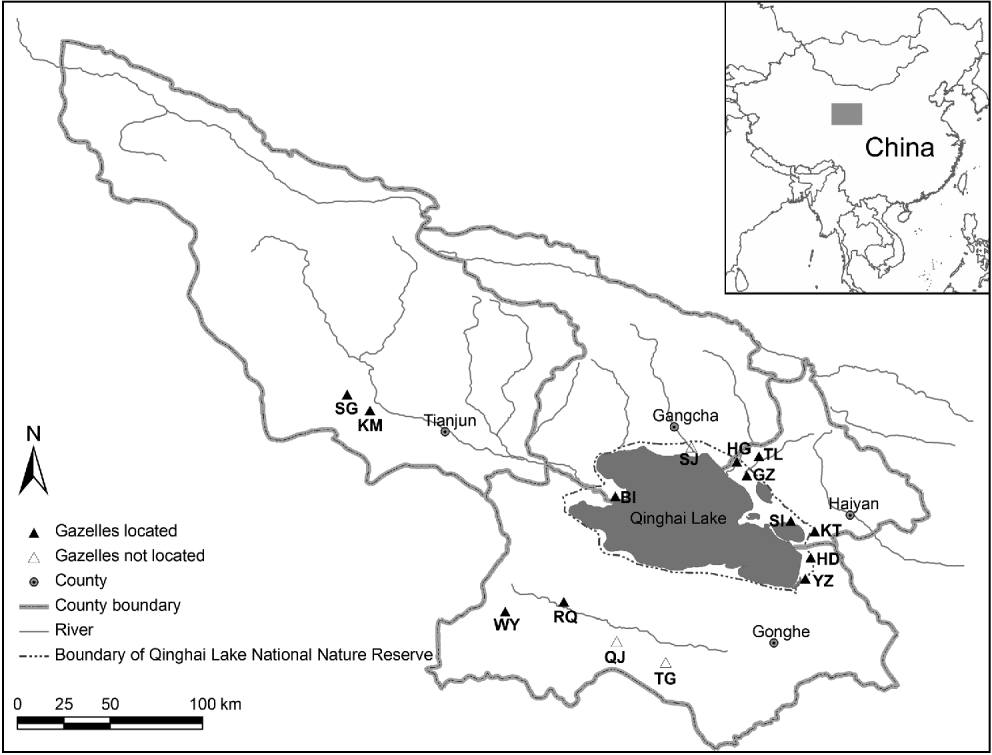
Fig. 1 Occurence of Przewalski's gazelle Procapra przewalskii at the 16 sites surveyed around Qinghai Lake: YZ, Yuanzhe; HD, Hudong; KT, Ketu; SI, Sand Island; GZ, Ganzihe (including GZs); HG, Hargai; TL, Taliexuanguo; BI, Bird Island; SG, Shengge; QJ, Qieji; SJ, Sanjiaocheng; KM, Kuairma; WY, Wayu; RQ, Ranquhu; TG, Tanggermu. The shaded rectangle on the inset indicates the location of the main map in China.
Methods
From March 2008 to July 2009 we conducted preliminary research, including a literature review and interviews with local wardens and pastoralists, to identify areas potentially inhabited by Przewalski's gazelle. We then carried out a field survey at the 16 sites identified, from July to September 2009 (60 days in total; Fig. 1). The surveys were conducted, on sunny days only, by two trained field workers, on foot, using binoculars and/or telescope, whilst walking at a mean speed of 2 km h−1 in early morning and late afternoon (the times when Przewalski's gazelle is most active). To avoid double-counting because of possible movement of gazelles between neighbouring subpopulations, we completed censuses at a site within 2–3 days and rechecked it after finishing the neighbouring census to ensure that no significant movement had occurred between the sites.
In our previous surveys (Jiang et al., Reference Jiang, Li and Wang2000) we used the total count method to census Przewalski's gazelle but no confidence interval can be calculated for this method. In this study we therefore used both the total count method and distance sampling (Buckland et al., Reference Buckland, Anderson, Burnham, Laake, Borchers and Thomas2001; Thomas et al., Reference Thomas, Buckland, Burnham, Anderson, Laake, Borchers and Strindberg2002); the latter was not used at the sites where there were too few gazelles or where the gazelles were aggregated in clusters of > 100 (Table 1). For all surveys we recorded the date, time, location (with a global positioning system, GPS), cluster size, cluster composition, gazelle behaviour and vegetation type and, where appropriate, detection distance and bearing and estimated perpendicular distance for distance sampling. Detection distances were measured with a laser rangefinder (with an accuracy of ± 1 m over 30–4,000 m). Bearings were taken using the electronic compass function of a GPS.
Table 1 For each of the 16 sites (Fig. 1), the number of GPS points used to calculate the area occupied by each subpopulation of Przewalski's gazelle Procapra przewalskii, whether a site was newly discovered or not, the number of transects surveyed, their total length and total number of surveys, the number of groups sighted, and the survey methods used.
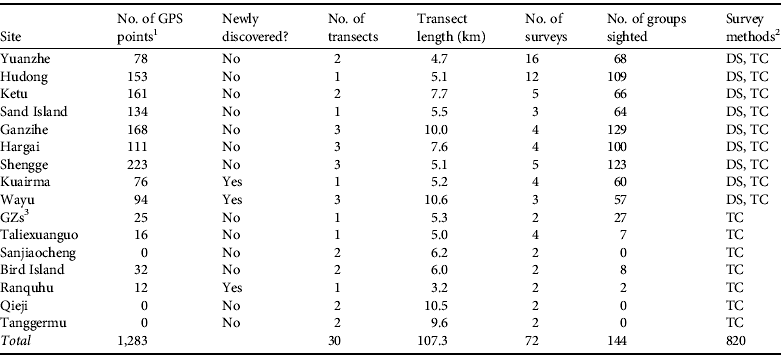
1 Number of GPS points of activity signs, sightings and faeces (including records during the current and previous field work, covering all seasons in 2008 and spring in 2009)
2 DS, distance sampling; TC, total count
3 GZs is a small area within Ganzihe where Przewalski's gazelle was foraging in large herds and thus where distance sampling was not appropriate (S. Buckland, pers. comm.)
For the total count method we travelled through the entire potential gazelle habitat at a site, ascending high points where available. To avoid repeat counts of the same individuals we avoided disturbing the gazelles, as far as possible, and noted their direction of movement. For distance sampling we first demarcated transect lines in areas of Przewalski's gazelle activity. We used a GPS to guide our walks along the transects. Repeated censuses of the same transects were conducted on different days to obtain at least 60 sightings for each subpopulation, as suggested by Buckland et al. (Reference Buckland, Anderson, Burnham and Laake1993, Reference Buckland, Anderson, Burnham, Laake, Borchers and Thomas2001).
We recorded the locations, with a GPS, of residential sites, roads, perennial and artificial water sources, fences, and any remains and activity signs of Przewalski's gazelle. Heights of any fences were measured at nine sites (Yuanzhe, Hudong, Ketu, Sand Island, Ganzihe, Hargai, Shengge, Kuairma and Wayu) where there are fences in the gazelle's habitat. We collected any remains of Przewalski's gazelles and recorded the gender, age, cause of death and location, with a GPS.
Census data for distance sampling were analysed with Distance v. 6.0 (Thomas et al., Reference Thomas, Laake, Rexstad, Strindberg, Marques and Buckland2009). The data were 5% right-truncated and the model with the lowest Akaike's Information Criterion was selected as the best fit (Akaike, Reference Akaike, Petrv and Csaki1973; Buckland et al., Reference Buckland, Anderson, Burnham, Laake, Borchers and Thomas2001). Calves were excluded from the analysis to avoid underestimation of the detection probability, caused by a lower detection probability for some orphaned calves (Thomas et al., Reference Thomas, Buckland, Burnham, Anderson, Laake, Borchers and Strindberg2002). We estimated the number of calves directly from the total count and calculated the ratios of calves to adult females using the data from repeated surveys. Locations of sightings and faeces of Przewalski's gazelle (including records during the current and previous field work covering all seasons in 2008 and spring in 2009) were used to calculate the species’ range using the minimum convex polygon (MCP) and 95% fixed kernel methods in the Animal Movement Analysis extension for ArcView v. 3.3 (ESRI, Redlands, USA). The density of roads, fences and residential sites were calculated in ArcView v. 3.3 using the GPS locations of these anthropogenic facilities.
Interviews with local herdsmen and officials in Qinghai Lake National Nature Reserve provided information about domestic livestock, illegal poaching, predation risk from wolves Canis lupus and Tibetan fox Vulpes ferrilata and conservation actions for Przewalski's gazelle. Provincial statistical yearbooks and local governments were consulted for socio-economic information about people living around Qinghai Lake. Data from the Fifth National Census (2001) were used to map human population density around the Lake, using the Geostatistical Analyst module of ArcGIS v. 9.2 (ESRI, Redlands, USA). The severities of the potential threats to Przewalski's gazelle were estimated for each subpopulation based on data collected during preliminary interviews and our field work.
Results
Distribution and population size
We located Przewalski's gazelle in 13 of the 16 sites surveyed, in a total area of c. 250 km2 (Table 2). Movement of gazelles between the surveyed sites is impeded by geographical and human-induced isolation (Fig. 1). We surveyed a total length of 339.5 km and counted 776 groups of gazelles at the nine sites where distance sampling was employed and 44 groups at the other seven sites. No sightings were recorded at a distance > 1.4 km. In the total counts we recorded 1,544 gazelles. The adult population size estimated with Distance at the nine sites where distance sampling was employed was 940. Adding the number of calves recorded, the estimated population size of these sites was 1,258. Adding to this the total count for the seven sites where only the total count method was used gives an estimated total population size of 1,635.
Table 2 Population size and composition, and area occupied by, and density of, adult Przewalski's gazelle at each of the 16 surveyed sites (Fig. 1).
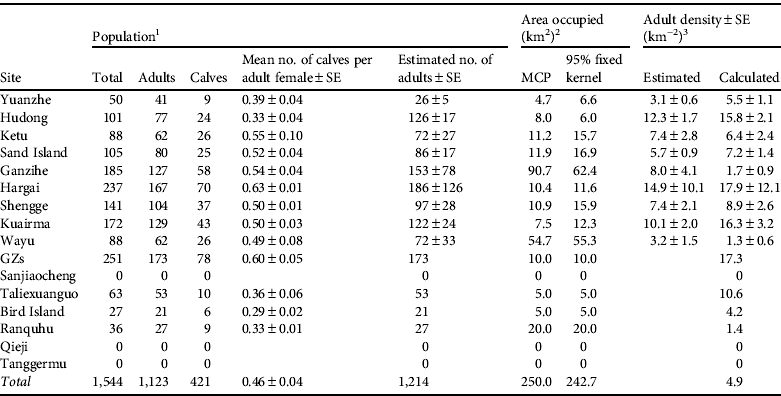
1 Total, numbers of adults and calves, and mean number of calves per female were obtained from the total counts; the estimated no. of adults was determined from distance sampling.
2 Calculated with both the minimum convex polygon (MCP) and a 95% fixed kernel. Area occupied by the species at GZs, Taliexuanguo, Bird Island and Ranquhu was estimated from our knowledge and experience as the number of GPS points of signs of Przewalski's gazelle activities were < 50.
3 Estimated: densities of adults at sites where distance sampling was used, estimated by Distance. Calculated: density determined from the estimated number of adults divided by the area of the MCP of the area occupied by the species at each site.
About 300 individuals (c. 20%) were detected at three sites where the gazelle has not previously been reported: Kuairma, Wayu and Ranquhu (discovered in 2004, 2008 and 2009, respectively). The density of adults estimated with the total count method and distance sampling was 4.5 and 4.9 km−2, respectively. Based on our total counts and those reported by Ye et al. (Reference Ye, Ping, Peng, Lu and Ma2006) the mean annual population growth rate was 6.17% although not all subpopulations increased (Table 3). Local pastoralists indicated that there may be a few gazelles in Sanjiaocheng and Qieji but we did not find any signs of gazelles there. We did not find any signs of gazelles at Tanggermu and local residents indicated they had not seen any there since 2003.
Table 3 Population trends of Przewalski's gazelle and the degree of the main threats (habitat fragmentation, human density, effect of fences, habitat degradation, competition with livestock, predation and poaching) to the species at the 16 sites surveyed. The degree of impact of the threats was categorized as no occurrence (N), low (+), medium (++) and high (+++).

1 Derived from a comparison between the current study and Ye et al. (Reference Ye, Ping, Peng, Lu and Ma2006).
2 Mainly caused by fences, roads and railways.
3 Density of fences (km km−2): +, 0< 2; ++, 2≤4; +++, ≥4.
4 +, only a few small roads used by pastoralists; ++, one highway or railway surrounding only one side of the area; +++, one highway or railway surrounding more than one side of the area.
5 Number of families km−2: +, 0< 0.25; ++, 0.25≤0.75; +++ ≥0.75.
6 Number of Przewalski's gazelles killed or injured per year by fences: +, 0< 2; ++, 2≤5; +++, ≥5.
7 +, High habitat quality with no desertification; ++, low habitat quality with slight desertification; +++, severe desertification (Tang & Wang, Reference Tang and Wang2009).
8 Number of livestock km−2: +, 0 < 50; ++, 50≤100; +++, ≥100.
9 Number of observed remains of Przewalski's gazelles killed by wolf or Tibetan fox: +, 0< 2; ++, 2≤4; +++, ≥4.
10 Information from informal interviews with local pastoralists and wardens: +, one occurrence in previous year; N, no occurrence in previous year.
Potential threats
The intensity of the potential threats varied between sites (Table 3). The human population around Qinghai Lake has increased tenfold and livestock fourfold in the previous 5 decades (Fig. 2). The height of fences ranged from 100.3±SE 13.7 to 111.9±SE 12.0 cm and the length of fences per km2 of grassland was 1.16–6.64 km. We often found (in c. 100 observations) that Przewalski's gazelle was reluctant or unable to cross fences. Even though local pastoralists reported occasional movements of gazelles between Ganzihe, GZs and Hargai (through four railway passages), Shengge and Kuairma, and Wayu and Ranquhu, we did not witness movements between other subpopulations. The increased human population and domestic livestock now restrict the gazelle to patches of low human density (Fig. 3). Poaching has not been a key threat following the extensive confiscation of guns by the government in the 1990s. In the last 10 years local pastoralists only witnessed one incident of poaching, for meat, in each of Yuanzhe, Hudong and Wayu (Table 2). Predation, however, is still a threat. We observed a mean of c. 2.4 remains of Przewalski's gazelles per subpopulation killed by wolves during the 60-day field census, and remains of calves were found near burrows of Tibetan fox in Yuanzhe (one calf), Ketu (two), Ganzihe (four) and Shengge (one). Field patrols of the Qinghai Lake Nature Reserve at Ganzihe from October 2009 to April 2010 recorded the deaths of 32 Przewalski's gazelles killed by wolves.
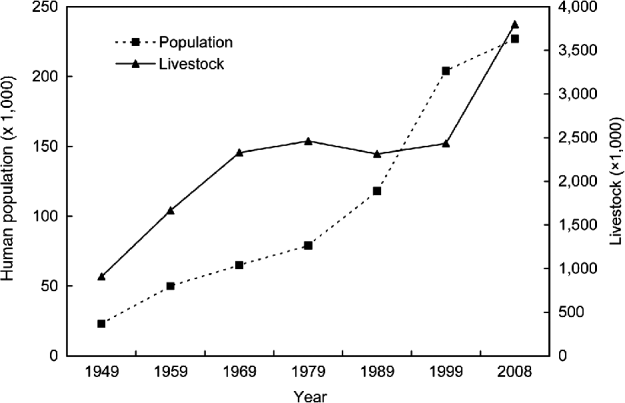
Fig. 2 Growth of the human population and livestock in four counties (Haiyan, Gangcha, Gonghe and Tianjun) combined around Qinghai Lake (Fig. 1).
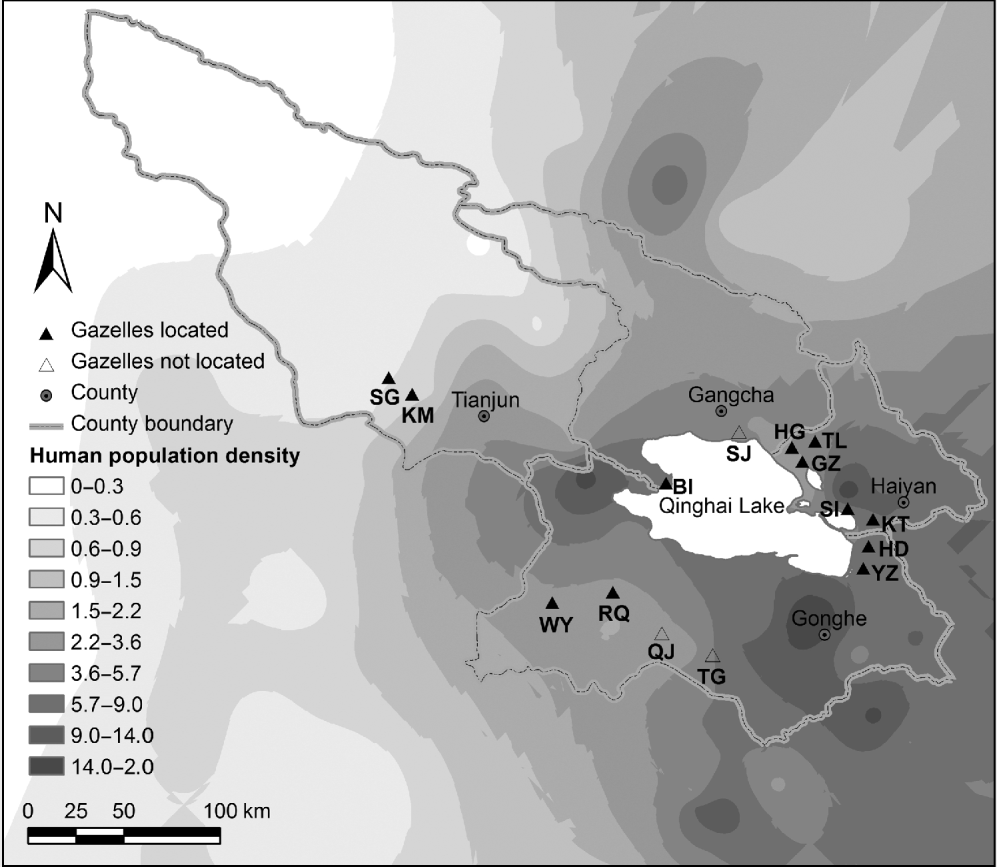
Fig. 3 Human population density (individuals per km2) around Qinghai Lake and distribution range of Przewalski's gazelle.
Conservation actions
Wardens of Qinghai Lake National Nature Reserve conduct regular field patrols. Poaching is prohibited and this is enforced with the aid of local forestry police. Sixteen fence passages (breaches of 4-m in length) and eight artificial pools were established and 20 km of wire fences were lowered or removed in 2008 under the auspices of the EU–China Biodiversity Programme. However, we did not see any signs of Przewalski's gazelles using the water pools or fence passages during our surveys. The Wildlife Rescue Center in Bird Island has rescued 20 Przewalski's gazelles since its establishment in 2002 and two reproductive females in the Wildlife Rescue Center successfully produced six calves from 2002 to 2008. However, a viable population is not yet established in captivity.
Discussion
Population status and potential threats
The difference in the estimate of the total population of Przewalski's gazelles using only the total count (1,544) and the total count plus distance sampling (1,635) was small, suggesting acceptably accurate results. Excluding the newly reported subpopulations at Kuairma, Wayu and Ranquhu, the mean annual population growth rate was 6.17% since 2003. The increase in the density estimated by the total count method (4.5 adults km−2 vs 2.34 km−2 in 2001 and 0.82 km−2 in 2004) may partly result from differences in estimating area rather than any absolute population size increase (Lei et al., Reference Lei, Jiang and Liu2001; Liu & Jiang, Reference Liu and Jiang2004). The calf to adult female ratio appears to be correlated with subpopulation size (Table 2), and this requires further investigation.
The total number of Przewalski's gazelle remains small despite the growth in the population. As the human population of the area has increased, desertification within the range of Przewalski's gazelle has increased fourfold since 1956 because of overgrazing (Tang & Wang, Reference Tang and Wang2009). Together with roads, railways and human activities, fences fragment the grassland habitat of the gazelle (Li et al., Reference Jiang2009a; Tang & Wang, Reference Tang and Wang2009). Habitat fragmentation in a degraded matrix prevents gene flow between subpopulations and results in reduced genetic diversity (Gibbs, Reference Gibbs2001; Lei et al., Reference Lei, Hu, Jiang and Yang2003; Dixo et al., Reference Dixo, Metzger, Morgante and Zamudio2009). Fences not only fragment habitat but also injure and kill gazelles (Fox et al. Reference Fox, Dhondup and Dorji2009; Mallon & Jiang, Reference Mallon and Jiang2009) and can prevent them escaping from predators; the remains of gazelles killed by wolves have been found near such fences (You Z. et al., unpubl. data). However, it is impossible to remove fences in such a large area because they are convenient for paddock management (Banks et al., Reference Banks, Richard, Li and Yan2003). Spatial overlap and food competition (c. 80% overlap) with domestic livestock, especially during food-limited seasons (Liu & Jiang, Reference Liu and Jiang2004; Li et al., Reference Li, Jiang and Li2008) are intensified as the number of livestock increases around Qinghai Lake. Additionally, possible transmission of infectious diseases between wild animals and domestic livestock could be of concern (Morgan et al., Reference Morgan, Lundervold, Medley, Shaikenov, Torgerson and Milner-Gulland2006; Smith et al., Reference Smith, Acevedo-Whitehouse and Pedersen2009).
Following the cessation of hunting in the 1990s (Harris, Reference Harris2008) predation has become one of the most serious threats to the survival of Przewalski's gazelle because of the growth of the wolf population around Qinghai Lake (Jiang et al., Reference Jiang, Li and Wang2000). Predation on the physically drained male adults in the rutting season, lambing females and calves significantly affects growth of the gazelle population (Jiang, Reference Jiang2004, Reference Jiang2008). In another study in three of the locations where Przewalski's gazelle occurs we found that depredation of livestock is a growing problem that local pastoralists attribute to the increasing population of wolf and Tibetan fox (Li C. et al., unpubl. data). Appropriate controls on growth of the wolf and fox population need to be considered.
There are considerable effects of vigilance costs on survival, reproductive success and abundance in other gazelle species (Manor & Saltz, Reference Manor and Saltz2004; Preisser et al., Reference Preisser, Bolnick and Benard2005; Gingold et al., Reference Gingold, Yom-Tov, Kronfeld-Schor and Geffen2009). Monitoring threats from predators, human intrusions and shepherd dogs may reduce access to resources, mates and reproductive success (Illius & Fitzgibbon, Reference Illius and Fitzgibbon1994; Fortin et al., Reference Fortin, Boyce, Merrill and Fryxell2004; Li et al., Reference Li, Jiang and Beauchamp2009b). Although there is little information about any such effects on Przewalski's gazelle this subject warrants investigation.
Conservation status
The population growth of Przewalski's gazelle since the 1980s can be mainly attributed to the establishment of protected areas and a nationwide prohibition on poaching. Four subpopulations (Bird Island, Sand Island, Ganzihe and Hargai), with c. 59% of the total population of Przewalski's gazelle, are protected within Qinghai Lake National Nature Reserve and, except for that of Bird Island, have increased within the last 2 decades (Jiang et al., Reference Jiang, Feng, Wang, Chen, Cai and Li1995; Ye et al., Reference Ye, Ping, Peng, Lu and Ma2006). Only three cases of poaching for meat have been observed by local pastoralists outside the Reserve in the last 10 years. Following the raising of local conservation awareness the majority of local pastoralists support the conservation of Przewalski's gazelle (Hu et al., Reference Hu, Ping, Cai, Li, Li and Jiang2010).
However, the conservation of the c. 41% of the population of Przewalski's gazelle that live outside the Reserve needs to be addressed. New conservation facilities such as the fence passages and artificial water pools, established in 2008, are not yet being used by the gazelles but they may require further time to become accustomed to these structures. Although local involvement plays an important role in preserving threatened species (Maroney, Reference Maroney2005) intensified conflict between people and Przewalski's gazelle will be unavoidable if the population of the gazelle continues to increase. The grazing pastures around Qinghai Lake are contracted to local pastoralists by the state for 70 years and Qinghai Lake National Nature Reserve has no right to manage the paddocks or to control livestock grazing. More efforts will need to be made to resolve the intensifying conflict between people and Przewalski's gazelle. Of geographical distance, topography, human settlement, roads and railways, Yang et al. (Reference Yang, Jiang, Zeng, Turghan, Fang and Li2011) found that human settlement is the main factor shaping the genetic differentiation of Przewalski's gazelle. This further illustrates the importance of collaboration with the local community.
Conservation recommendations
Despite the recategorization of Przewalski's gazelle on the IUCN Red List from Critically Endangered to Endangered because the number of mature individuals was estimated to be 350–400 or greater (Jiang et al., Reference Jiang, Feng, Wang, Chen, Cai and Li1995, Reference Jiang, Lei, Han and Li2003; Jiang, Reference Jiang2004; IUCN SSC Antelope Specialist Group, 2008), the survival of the species is not yet secure. There are two principal emerging challenges: limitation of available habitat and human–gazelle conflict. We make the following recommendations for the long-term conservation of the species. Firstly, management and conservation strategies need to incorporate comprehensive knowledge of the gazelle, including that of local communities. Secondly, the long-term monitoring needs to continue. Thirdly, captive breeding of injured and orphaned gazelles should be instigated, to form a potential pool of individuals for future reintroductions to the historical range of the species outside the Qinghai Lake basin.
Acknowledgements
We appreciate the support of the Administration of Qinghai Lake National Nature Reserve and the Wildlife and Nature Reserve Management Bureau of Qinghai Province. We are grateful to Tsranben, Nuodetsran and Huaqingjia for their assistance in the field and to Dr Steve Buckland for help in using distance sampling. Our work was supported by Science and Technology Supporting Project of MOST (2008BAC39B04), State Forestry Administration, and the Sir Peter Scott Fund of the SSC/IUCN.
Biographical sketches
Chunlin Li is interested in animal behaviour and wildlife conservation, and is also studying vigilance behaviour of, and landscape connectivity for, Przewalski's gazelle. Zhigang Jiang's work focuses on animal conservation, particularly the threatened mammals of China. His research group studies Przewalski's gazelle, Tibetan gazelle and antelope, the Mongolian wild ass, argali, blue sheep, yak, goral, wild sika and Père David's deer, and recently the snow leopard, brown bear and tiger. Xiaoge Ping is involved in research on biodiversity conservation and internationsl trade in threatened species of wild fauna and flora. Jing Cai studies human–wildlife conflict in China. Zhangqiang You works on animal behaviour, with a focus on the mating system of Przewalski's gazelle. Chunwang Li is interested in animal behaviour and conservation. Yonglin Wu works in the Administration of the Qinghai Lake National Nature Reserve, with a special interest in the conservation of Przewalski's gazelle.








